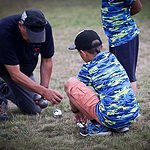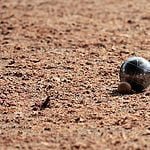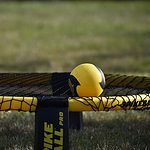To play professional Spikeball like a pro, mastering the art of deception in your shots is crucial. By creating uncertainty in your opponents' minds, you can gain a significant advantage on the court.
But how exactly do you perfect this skill to outsmart your competition and dominate the game? Let's explore the key strategies and techniques that can take your Spikeball game to the next level and help you compete like a true pro.
Key Takeaways
- Master Spikeball techniques through dedicated practice and diverse strategies.
- Position strategically, communicate effectively, and coordinate seamlessly with teammates.
- Read opponents' movements, analyze gameplay, and adapt tactics for competitive advantage.
- Develop mental toughness, focus on skill enhancement, and stay adaptable for professional success.
Mastering the Spikeball Serve
To excel at playing professional Spikeball, master the Spikeball serve through consistent practice and strategic variation in your serves. When hitting the ball to start a point, focus on perfecting your tosses. The toss is crucial as it sets up the entire serve, allowing you to control the direction and power of your shot. Incorporating drop shots into your serve repertoire adds unpredictability to your game. By mixing in drop shots with your regular serves, you can catch your opponents off guard and force them out of their comfort zone.
Tossing the ball accurately and timing your hit perfectly for optimal contact is key to executing successful drop shots. Varying between drop shots and more traditional serves keeps your opponents guessing and prevents them from settling into a rhythm. Experiment with different toss heights and spins to add complexity to your serves. Mastering the drop shot can be a game-changer, allowing you to maintain the element of surprise and gain a competitive edge on the Spikeball court.
Positioning and Court Awareness
Position yourself strategically on the Spikeball court to maximize your coverage and anticipate plays effectively, enhancing your overall performance in the game. By positioning yourself in the right spots, you can ensure you cover more ground and effectively receive or return the ball onto the net.
Being aware of your teammate's positioning is crucial in the sport of roundnet; it allows you to coordinate plays smoothly and cover each other's weaknesses, taking your game to the next level. Keep a close eye on the ball's trajectory and speed to react promptly and execute precise plays.
Understanding the angles and distances on the Spikeball court is essential for optimizing your offensive and defensive positioning. Moreover, anticipate your opponents' movements by observing their body language and court positioning, giving you a competitive edge.
Communication and Team Strategy
Optimize your team's performance and cohesion in professional Spikeball matches by prioritizing clear communication and strategic coordination. Effective signals and synchronized movements are crucial in ensuring that your team operates as a well-oiled machine on the court. By developing a set of hand signals and verbal cues, you can enhance your tactical communication and enable quick reactions to the ever-changing game dynamics.
Team cohesion is built on a foundation of strategic planning and adaptability. Setting up plays, positioning yourselves effectively, and being ready to adjust your strategy on the fly are all key aspects of successful team coordination. Good communication fosters trust among players and enables a cohesive gameplay strategy that can outsmart even the toughest opponents.
In professional Spikeball, the ability to read each other's movements and intentions through non-verbal cues is a game-changer. By honing your communication skills and working on synchronized movements, you can elevate your team's performance to a professional level.
Reading Your Opponents' Movements
Observing your opponents' movements and body language is essential in anticipating their next actions effectively during a professional Spikeball match. By paying attention to body language cues, you can gain a strategic advantage by predicting your opponents' moves.
Analyzing their footwork and hand placements helps in movement prediction, giving you a tactical advantage in positioning yourself for a successful defensive play. Furthermore, by closely observing their reactions to your serves and hits, you can identify patterns and adjust your game plan accordingly, creating game adjustment opportunities.
Look for subtle signs in how they position themselves or react to different situations to exploit weaknesses in their playstyle. Stay focused and observant throughout the game to consistently read and react to your opponents' movements, giving you an edge in outsmarting them on the Spikeball court.
Advanced Hitting Techniques
To enhance your performance on the Spikeball court, mastering advanced hitting techniques is crucial for outmaneuvering your opponents and securing victory. Precision placement, strategic spiking, and tactical timing are key elements to elevate your game.
By mastering the art of hitting angles, you can exploit your opponent's defenses effectively, creating openings for scoring. Practice hitting with varying speeds and spins to keep your opponents off balance, making it harder for them to anticipate your moves.
Focus on timing and anticipation to consistently execute powerful and accurate hits, putting pressure on your opponents. Utilize feints and fakes to deceive your opponents, setting up scoring opportunities and gaining the upper hand.
Experiment with different hand positions and grips to generate diverse shot trajectories, keeping your opponents guessing. Incorporating these advanced hitting techniques won't only make you a formidable Spikeball player but also give you a competitive edge on the court.
Defensive Play and Blocking
Positioning yourself strategically between your opponent and the net is essential for effective shot blocking in Spikeball. To excel in defensive play and blocking, consider the following:
- Blocking Techniques and Defensive Strategies: Study your opponent's hitting tendencies to anticipate where they might aim. By understanding their patterns, you can position yourself more effectively to block shots. Vary your blocking techniques to keep your opponent guessing and maintain a strong defensive presence.
- Net Presence and Anticipation Skills: Focus on your positioning near the net to cut off angles and limit your opponent's options. Anticipate where the ball might be hit based on your opponent's movements and positioning. Being proactive in your anticipation can give you a crucial edge in blocking shots effectively.
- Reaction Time and Footwork Coordination: Develop quick reflexes and agile footwork to react swiftly to incoming shots. Work on your footwork coordination to move efficiently around the net and adjust your positioning as needed. Improving your reaction time can help you make timely blocks and disrupt your opponent's offensive flow.
Fitness and Conditioning for Spikeball
Enhance your performance in Spikeball by focusing on your fitness and conditioning regimen, incorporating key exercises to boost agility, strength, endurance, and explosiveness.
To improve agility, integrate speed training drills like ladder drills and cone drills to enhance your footwork and reaction time during intense spikeball rallies. Strengthen your core with exercises such as planks, Russian twists, and leg raises to increase stability and power in your spikeball movements.
Endurance is crucial for longer matches, so include cardio workouts like running, cycling, or HIIT sessions in your training routine. Develop explosive power for quick movements by incorporating plyometric exercises like jump squats, burpees, and box jumps.
Additionally, prioritize flexibility training with stretches, yoga, or dynamic warm-ups to prevent injuries and maintain mobility on the spikeball court. By focusing on agility, strength conditioning, endurance, flexibility, and injury prevention, you can elevate your spikeball game to a professional level.
Mental Toughness and Focus
Strengthen your mental game in professional Spikeball by honing your focus and developing unwavering resilience to excel under pressure. To achieve this, consider the following:
- Visualization techniques and concentration training: Visualize successful plays and strategies, allowing your mind to prepare for different game scenarios. By focusing on the ball and your opponents' movements, you can anticipate plays accurately and make split-second decisions with precision.
- Mental fortitude and resilience building: Develop the mental strength to handle pressure situations and maintain composure during intense rallies. Building resilience will help you stay calm and focused, even when faced with challenging moments on the court.
- Mindfulness exercises and focus enhancement: Practice mindfulness techniques to enhance your focus and block out distractions. Stay present in the moment, utilizing breathing exercises and relaxation techniques to manage stress and ensure mental clarity during competitive matches.
Practice Drills for Skill Improvement
To elevate your skills in professional Spikeball, engage in structured practice drills focusing on improving key aspects of your game. Start by incorporating precision drills and consistency exercises with a partner to enhance your hitting accuracy and maintain a steady performance level.
Practice timed rallies to boost your reaction speed and ball control, crucial for quick and precise plays during matches. Work on footwork and positioning drills to sharpen your court awareness, allowing you to anticipate plays better.
Utilize target hitting drills to improve shot placement and enhance your overall precision in the game. Additionally, implement defensive drills to develop quick reflexes and improve your anticipation skills, crucial for effectively countering opponent shots. By consistently practicing these drills, you'll refine your skills and elevate your performance in professional Spikeball games.
Competing in Spikeball Tournaments
When preparing to compete in Spikeball tournaments, ensure you have practiced consistently with a partner to develop chemistry and communication on the court. To succeed in tournament play, here are three key aspects to focus on:
- Tournament Preparation, Mindset: Approach each tournament with a positive and focused mindset. Be mentally prepared for the challenges ahead, stay composed during intense matches, and adapt to different playing styles you may encounter.
- In-Game Adjustments, Adaptability: Be ready to make quick adjustments during matches. Stay flexible in your strategies, adapt to your opponents' strengths and weaknesses, and be willing to change tactics on the fly to gain an advantage.
- Competition Strategy, Teamwork Dynamics: Develop a solid game plan with your partner. Understand each other's strengths, communicate effectively on the court, and work together seamlessly to outsmart your competition. Building strong teamwork dynamics can give you the edge in intense tournament matchups.





